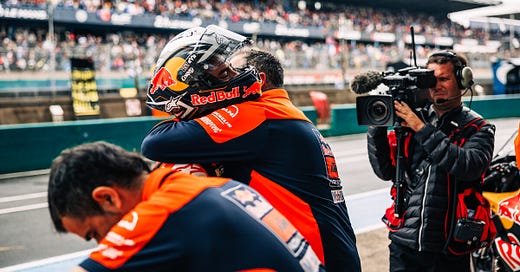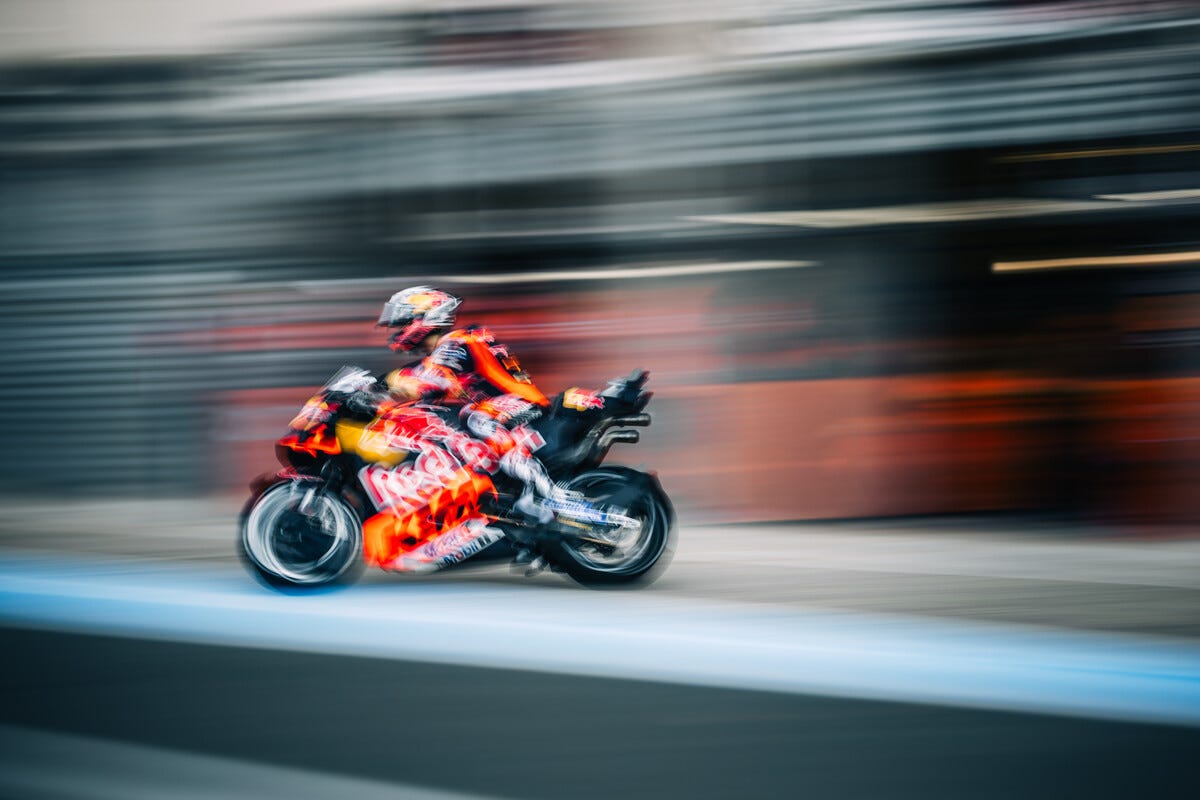MotoGP: “The live broadcast is still the most important thing.”
Director Enrique Sierra explains how the live TV production is still key for MotoGP, what to show and when and whether the operation will one day be fully remote.
By Adam Wheeler. Action photos by Polarity Photo.
Dorna Sports send almost 200 professionals to each round of MotoGP to provide more than 36,000 hours of live TV broadcasting and accommodate contracts with 117 media partners in 200 countries. It is one of the main revenue pots for the company and the championship but creating a ‘live feed’ that involves action from variable angles, reports and filtering into OTT content is also a major outlay. There is a trackside network that involves more than 20 and sometimes close to 30 units, as well onboards, remote RFs [Radio Frequency cameras), drones, a heli-cam and even autonomous technology – cameras that film the action without human assistance. The feed can count on input from over 150 channels during a Grand Prix weekend and behind it all there is a sea of “technicians, directors, graphics and replay operators, journalists,” explains Live Director Enrique Sierra.
Live sport is apparently still a draw for broadcasters and streamers, and still essential for promoters. In an article written in February, Forbes.com quoted a study from Ampere Analytics that said in 2025 streaming services will account for ‘one-fifth of global sports rights spend, reaching over $12 billion.’ It could be argued that fans and viewers are digesting sports in different ways: delayed viewing, social media clips, YouTube highlights and other media outlets but Sierra says the root of all moving content is the live feed. “The Live broadcast is still the most important thing,” he states. “I think it’s the base. We don’t have social media [content] if we don’t have the Live but it is changing…and for this we have to keep pushing to make sure we have the technology we want and need. The Live still needs to be five-star, and the broadcast partners pay for this product. It’s a premium service in coverage.”
“There are always budget discussions,” he reveals on the split between investment for track action and more resources for social media. “Right now, we have our budget confirmed for a couple of years but if we want to improve then we need to keep investing. We are in a different situation now [with demands for social media] compared to five years ago.”
The 51-year-old Spaniard is at the helm of Dorna Sports’ vast TV structure and a department that has always pushed for fresh and innovative ways to televise Grand Prix, thanks to the impetus of people like Sergi Sendra and Manel Arroyo who helped craft a large visual and commercial base for the series. TV revenue helps support large sections of the paddock. Sierra is responsible for the MotoGP class signal while he has other directors for other categories. The production on raceday is like coordination of a sizeable symphony orchestra.
“It’s important to have the team happy and motivated,” he describes. “You want to reduce the amount of ‘noise’ around you. It’s like being in another world for two-hours. You just connect with the race and the team. The secret is to be calm, but fast. Also to change the speed or rhythm of the work because there are many directors who are always ‘up’ and shouting for the angles when the race might be quite quiet.”
“You can change gears and make fast sequences that gives the viewer the feeling of ‘wow, look what’s happening!’ especially with overtaking,” he adds. “You have a method of sequencing and then it depends on what happens in the race. We have 60 onboard camera views and 16 channels and you can cut between front and rear, and that’s important because if cut away at the wrong moment to trackside then you can lose the feeling of action. It’s critical, and it also happens in hundredths of a second.”
The coverage of crashes is a polemic and delicate subject. Grand Prix’s last fatality came with Jason Dupasquier’s qualifying crash at Mugello for the 2021 Italian GP but accidents for Pol Espargaro (Portimao), Pecco Bagnaia (Catalunya) and Jorge Martin (Qatar) in recent seasons and shots of teams and family members in pitlane have also attracted commentary on what Dorna’s TV should show and of whom.
Sierra acknowledges the difficult mix between sensitivity and an informative relay. “You have to make quick decisions. You see the image, and then you have to decide if you cut to another because it’s a drama,” he explains. “You have to take care…and these critical moments are very difficult. Showing the human side is part of the racing, part of the story. It comes down to feeling and instinct in the moment. Behind me are journalists and other management that can help and maybe say ‘it’s a bad crash…’. We check the replays [away from the Live] and if the rider is not moving or in a bad way then we take care of what we show. This is the case from the time of the Simoncelli crash [Malaysia, 2011] where we will not show any replays until the rider seems to be moving and is OK.”
MotoGP is a sport entertainment product, yet the controller of its TV portrayal is conscious of his obligation. “It is a spectacular sport but of course we know the riders are playing with their lives,” he says.
MotoGP now involves 22 Grands Prix and 8 overseas rounds and Dorna’s global hike might be due for further review. Thanks to high-speed fibre optics, more and more Grands Prix could be directed from the company’s operational headquarters just outside Barcelona. Formula 1 already have a split structure with their Event Technical Centre at each circuit and the Media & Technology Centre at Biggin Hill in southern England piecing together their productions. Sierra still wants Dorna’s control hub on the ground at the tracks. “For many reasons,” he says. “One being the atmosphere and the tension of the race and the connection with the teams. Another is the quick ability to get to the track to see a new camera position.”
Sierra is an avid motorcyclist himself and even makes the timing laps with an official BMW on the day prior to the Grand Prix to get the best possible feeling for the course and the venue. “In terms of TV direction it is important to try and understand the sport and the discipline, in my case riding the laps gives me a feel of the track and I can try to bring that to the TV. It’s an advantage. We do what we can to be among the elite for TV sport production.”
He does admit that the days of hauling a full outfit to 22 GPs could dwindle, as soon as it makes fiscal sense. “The future does seem to be remote production,” he concedes. “It is a technological matter. There is a cost factor and the budget for travel and the entire crew being on-site is more or less the same [as using the fibre optic]. In the future though I think this will change and it will be cheaper to be in Barcelona than the circuit.”
Asking how Dorna could possibly improve their live TV feed going forwards gives ground for thought. “It’s a good question. Maybe we are at a level now we can lose more than we gain. It’s very satisfying to create good coverage of a good race. You have many tools, many cameras. How can we improve? Obviously, we have new cameras and new onboards. Things always change.”








